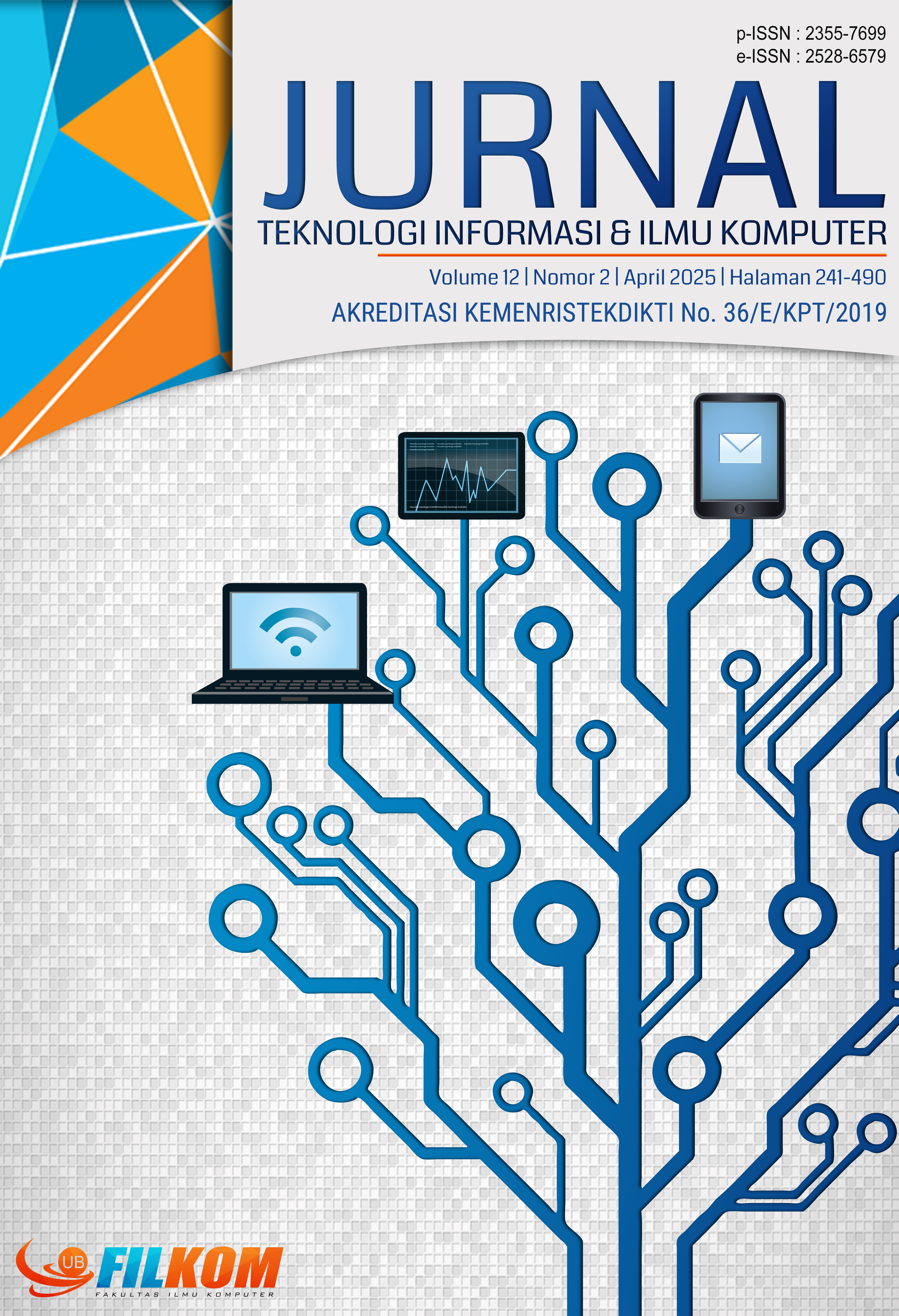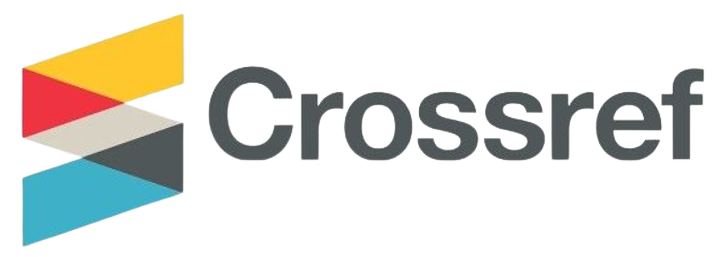Visualisasi Segmentasi Pelanggan Berdasarkan Atribut RFM Menggunakan Algoritma K-Means Untuk Memahami Karakteristik Pelanggan pada Toko Retail Online
DOI:
https://doi.org/10.25126/jtiik.2025128619Kata Kunci:
looker studio, segmentasi pelanggan, K-Means, RFM, retail online, visualisasi dataAbstrak
Meningkatnya minat belanja pelanggan toko retail online menimbulkan persaingan ketat antar retailer. Agar tetap unggul dan kompetitif, retailer perlu memahami karakteristik pelanggannya. Penerapan segmentasi pelanggan memberikan kemudahan pada retailer untuk memahami karakteristik pelanggan berdasarkan penilaian pada atribut yang dihitung dari data riwayat transaksi pelanggan. Hasil segmentasi pelanggan yang divisualisasikan dapat meningkatkan pemahaman retailer dalam memahami data dan membantu dalam proses pengambilan keputusan. Oleh karena itu, penelitian ini mengusulkan Visualisasi Segmentasi Pelanggan menggunakan Algoritma K-means berdasarkan Atribut RFM (Recency, Frequency, Monetary). Hasil segmentasi dapat digunakan untuk Memahami Karakteristik Pelanggan pada Toko Retail Online. Penelitian ini menggunakan algoritma k-means untuk menjalankan clustering yang performanya akan dibandingkan dengan algoritma k-medoids mengacu pada nilai silhouette, Calinski-Harabasz Index, dan DaviesBouldin Index dalam melakukan segmentasi pelanggan berdasarkan atribut RFM. Berdasarkan metrik tersebut, didapatkan nilai algoritma k-means berturut-turut adalah 0,6558, 0,7219, dan 3578,9, sedangkan nilai algoritma k-medoids adalah 0,4677, 0,8298, dan 1236,9. Dengan demikian, hasilnya menunjukkan bahwa kinerja clustering menggunakan k-means lebih baik daripada menggunakan k-medoids. Pada dashboard Looker Studio ditampilkan visualisasi data hasil segmentasi tersebut, kemudian diuji fungsionalitasnya dengan metode Blackbox Testing dan berhasil menyelesaikan semua skenario pengujian, kemudian dilakukan pengujian dengan metode UAT (User Acceptance Testing) dan mendapatkan predikat sangat layak.
Abstract
The growing interest in online retail shopping among customers has resulted in intense competition among retailers. To sustain a competitiveness, retailers need to understand characteristics of their customer. Implementation of customer segmentation facilitates retailers in understanding customer characteristics through assessments based on attributes derived from customer transaction history data. Visualization of customer segmentation results can enhance the retailer's understanding of data and assist in the decision-making process. Therefore, this study proposes the Visualization of Customer Segmentation using the K-means Algorithm based on RFM Attributes (Recency, Frequency, Monetary). The segmentation results can be utilized to understand the characteristics of customers in an online retail store. This study explores the k-means algorithm to execute clustering, and its performance will be compared with the k-medoids algorithm, based of silhouette values, Calinski-Harabasz Index, and Davies Bouldin Index in customer segmentation based on RFM attributes. Based on given metrics, the consecutive performance values for k-means algorithm are 0.6558, 0.7219, and 3578.9, while k-medoids algorithm are 0.4677, 0.8298, and 1236.9. Thus, the results indicate that the clustering performance using k-means is better than using k-medoids. On the Looker Studio dashboard, the visualization of the segmentation data is displayed, and its functionality is tested using the Black Box Testing method, successfully completing all test scenarios. Subsequently, the system undergoes testing through the User Acceptance Testing (UAT) method and receives a highly satisfactory rating.
Downloads
Referensi
AL-HURMUZI, S., AL-KHANJARI, Z., & AI-KINDI, I. 2018. Proposed Feasible PEF framework for User Acceptance Testing. 2018 8th International Conference on Computer Science and Information Technology (CSIT), 242–248. https://doi.org/10.1109/CSIT.2018.8486225
ANITHA, P., & PATIL, M. M. 2022. RFM model for customer purchase behavior using K-Means algorithm. Journal of King Saud University - Computer and Information Sciences, 34(5), 1785–1792. https://doi.org/https://doi.org/10.1016/j.jksuci.2019.12.011
ARIF, E., & SOKO, I. P. 2022. The Evaluation of web-based and android face-to-face tutorial applications quality using the user acceptance testing (UAT) method. Journal of World Science. https://api.semanticscholar.org/CorpusID:251992255
ASHARI, I. F., BANJARNAHOR, R., FARIDA, D. R., AISYAH, S. P., DEWI, A. P., & HUMAYA, N. 2022. Application of Data Mining with the K-Means Clustering Method and Davies Bouldin Index for Grouping IMDB Movies. Journal of Applied Informatics and Computing. https://api.semanticscholar.org/CorpusID:250371540
BARILE, S., POLESE, F., & SARNO, D. 2018. Grocery retailing in the I4. 0 era. Symphonya. Emerging Issues in Management, 2, 38–51.
BHATIA, S. C. 2008. Retail management. Atlantic Publishers & Dist.
CHANG, E.-C., HUANG, S.-C., & WU, H.-H. 2010. Using K-means method and spectral clustering technique in an outfitter’s value analysis. Quality & Quantity, 44, 807–815.
CHEN, A. H. L., LIANG, Y.-C., CHANG, W.-J., SIAUW, H.-Y., & MINANDA, V. 2022. RFM model and K-means clustering analysis of transit traveller profiles: a case study. Journal of Advanced Transportation, 2022.
CHEN, D. 2019. Online Retail II. UCI Machine Learning Repository.
CHEN, D., SAIN, S. L., & GUO, K. 2012. Data mining for the online retail industry: A case study of RFM model-based customer segmentation using data mining. Journal of Database Marketing & Customer Strategy Management, 19, 197–208.
DUNNE, P. M., LUSCH, R. F., & CARVER, J. R. 2013. Retailing. Cengage Learning.
FAN, C., CHEN, M., WANG, X., WANG, J., & HUANG, B. 2021. A Review on Data Preprocessing Techniques Toward Efficient and Reliable Knowledge Discovery From Building Operational Data. Frontiers in Energy Research. https://api.semanticscholar.org/CorpusID:232387214
FATUROHIM, I., & BAITA, A. 2022. Penerapan Algoritma Kmeans Clustering Untuk Mengelompokkan Kerawanan Rob Di Daerah Pekalongan. JuTI “Jurnal Teknologi Informasi.” https://api.semanticscholar.org/CorpusID:251793749
ISTIYAN, N., NYOTO, R. D., & MUHARDI, H. 2020. Aplikasi Learning Management System Pada Jenjang Madrasah Aliyah. Justin (Jurnal Sistem Dan Teknologi Informasi), 8(1), 105–115.
JAI, T.-M. C., BURNS, L. D., & KING, N. J. 2013. The effect of behavioral tracking practices on consumers’ shopping evaluations and repurchase intention toward trusted online retailers. Computers in Human Behavior, 29(3), 901–909.
MARCUS, C. 1998. A practical yet meaningful approach to customer segmentation. Journal of Consumer Marketing, 15(5), 494–504. https://doi.org/10.1108/07363769810235974
MARTINO, A., & ROSSETTO, A. 2022. A Hybrid Score to Optimize Clustering Hyperparameters for Online Search Term Data. 2022 IEEE International Conference on Big Data (Big Data), 2317–2322. https://doi.org/10.1109/BigData55660.2022.10020638
MARUTHO, D., HANDAKA, S. H., WIJAYA, E., & MULJONO. 2018. The Determination of Cluster Number at k-Mean Using Elbow Method and Purity Evaluation on Headline News. 2018 International Seminar on Application for Technology of Information and Communication, 533–538. https://doi.org/10.1109/ISEMANTIC.2018.8549751
MIGLAUTSCH, J. R. 2000. Thoughts on RFM scoring. Journal of Database Marketing & Customer Strategy Management, 8, 67–72.
MORISADA, M., MIWA, Y., & DAHANA, W. D. 2019. Identifying valuable customer segments in online fashion markets: An implication for customer tier programs. Electronic Commerce Research and Applications, 33, 100822. https://doi.org/https://doi.org/10.1016/j.elerap.2018.100822
MUTANDWA, E., KANUMA, N. T., RUSATIRA, E., KWIRINGIRIMANA, T., MUGENZI, P., GOVERE, I., & FOTI, R. 2009. Analysis of coffee export marketing in Rwanda: Application of the Boston consulting group matrix. African Journal of Business Management, 3(5), 210.
NIDHRA, S., & DONDETI, J. 2012. Black box and white box testing techniques-a literature review. International Journal of Embedded Systems and Applications (IJESA), 2(2), 29–50.
PARASURAMAN, A. 1997. Reflections on gaining competitive advantage through customer value. Journal of the Academy of Marketing Science, 25(2), 154–161. https://doi.org/10.1007/BF02894351
PUSPITASARI, N., HAVILUDDIN, H., & PUADI, F. U. J. H. 2022. Klasterisasi Wilayah Penghasil Tanaman Lada Menggunakan Algoritma K-Means. Indonesian Journal of Computer Science, 11(3).
SAADEH, H., SAADEH, M., ALMOBAIDEEN, W., & AL-TAWIL, M. 2022. Evaluating the Optimal Number of Clusters to Identify Similar Gene Expression Patterns During Erythropoiesis. 2022
International Conference on Computer, Information and Telecommunication Systems (CITS), 1–5. https://doi.org/10.1109/CITS55221.2022.9832988
SADIKU, M., SHADARE, A. E., MUSA, S. M., AKUJUOBI, C. M., & PERRY, R. 2016. Data visualization. International Journal of Engineering Research And Advanced Technology (IJERAT), 2(12), 11–16.
SARMAH, R. DAS, KALITA, J. K., & BHATTACHARYYA, D. K. 2011. A pattern matching approach for clustering gene expression data. Int. J. Data Min. Model. Manag., 3, 130–149.
https://api.semanticscholar.org/CorpusID:10380267
SEVERIN, V., LOUVIERE, J. J., & FINN, A. 2001. The stability of retail shopping choices over time and across countries. Journal of Retailing, 77(2), 185–202.
SHARYANTO, S., & LESTARI, D. 2022. Penerapan Data Mining Untuk Menentukan Segmentasi Pelanggan Dengan Menggunakan Algoritma K-Means dan Model RFM Pada E-Commerce. JURIKOM (Jurnal Riset Komputer). https://api.semanticscholar.org/CorpusID:255665256
SYAKUR, M. A., KHOTIMAH, B. K., ROCHMAN, E. M. S., & SATOTO, B. D. 2018. Integration k-means clustering method and elbow method for identification of the best customer profile cluster. IOP Conference Series: Materials Science and Engineering, 336, 012017.
WANG, Y., TANG, S., LIANG, F., ZHANG, Y., & LI, J. 2013. Beyond Kmedoids: Sparse Model Based Medoids Algorithm for Representative Selection. In S. Li, A. El Saddik, M. Wang, T. Mei, N. Sebe, S. Yan, R. Hong, & C. Gurrin (Eds.), Advances in Multimedia Modeling (pp. 239–250). Springer Berlin Heidelberg.
ZAHARIA, S., & SCHMITZ, M. 2020. Customer Experience in Online-Retailing – An Analysis of the Main Segments in German Online-Retailing. In J. I. Kantola & S. Nazir (Eds.), Advances in Human Factors, Business Management and Leadership (pp. 177–188). Springer International Publishing.
Unduhan
Diterbitkan
Terbitan
Bagian
Lisensi
Hak Cipta (c) 2025 Jurnal Teknologi Informasi dan Ilmu Komputer

Artikel ini berlisensiCreative Commons Attribution-ShareAlike 4.0 International License.

Artikel ini berlisensi Creative Common Attribution-ShareAlike 4.0 International (CC BY-SA 4.0)
Penulis yang menerbitkan di jurnal ini menyetujui ketentuan berikut:
- Penulis menyimpan hak cipta dan memberikan jurnal hak penerbitan pertama naskah secara simultan dengan lisensi di bawah Creative Common Attribution-ShareAlike 4.0 International (CC BY-SA 4.0) yang mengizinkan orang lain untuk berbagi pekerjaan dengan sebuah pernyataan kepenulisan pekerjaan dan penerbitan awal di jurnal ini.
- Penulis bisa memasukkan ke dalam penyusunan kontraktual tambahan terpisah untuk distribusi non ekslusif versi kaya terbitan jurnal (contoh: mempostingnya ke repositori institusional atau menerbitkannya dalam sebuah buku), dengan pengakuan penerbitan awalnya di jurnal ini.
- Penulis diizinkan dan didorong untuk mem-posting karya mereka online (contoh: di repositori institusional atau di website mereka) sebelum dan selama proses penyerahan, karena dapat mengarahkan ke pertukaran produktif, seperti halnya sitiran yang lebih awal dan lebih hebat dari karya yang diterbitkan. (Lihat Efek Akses Terbuka).














